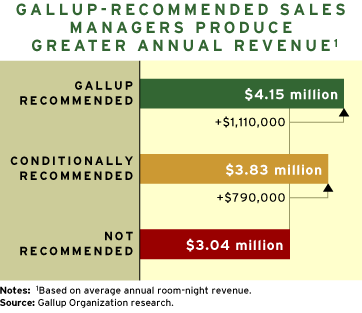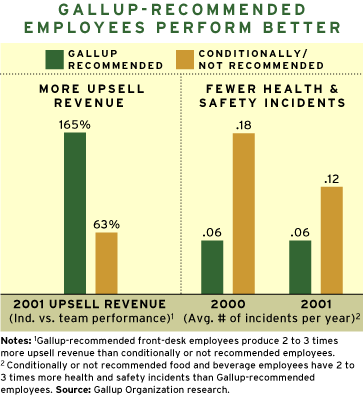Think about the last time you hired someone. Perhaps that person is now your top revenue earner and the most productive employee you've ever hired -- or perhaps not. Now, imagine how different your hiring process would have been if you had known the person's likelihood to succeed in the role -- before you hired that person.
Fairmont Hotels & Resorts, North America's largest luxury hotel management company, does know. Since 1999, Fairmont has tracked the performance of salespeople who are hired using a selection tool designed by The Gallup Organization. The result: Those whose interview results indicate they have talents similar to those of the most successful Fairmont salespeople -- or those with "recommend" ratings -- typically outperform those who rate a "conditional recommend" by $300,000 annually. And they surpass those with "not recommend" ratings by more than $1 million a year.
 |
That's not all. Preliminary analysis indicates that food and beverage managers, servers, and front-desk employees who rate a "recommend" also outproduce colleagues who fall into a "conditional" or "not recommend" category. "By correlating interview scores with performance, we know the return on investment of our recruitment strategy," says Carolyn Clark, Fairmont's vice president of human resources.
Fairmont has used Gallup-built selection systems since 1988. But only in the past few years have the two organizations teamed to track employees in a way that allows Fairmont to consistently link the results to job performance and, from there, to the company's bottom line. As the results cited above illustrate, the gains from identifying the best applicants are dramatic. But the true power of the story is that the process Fairmont uses to select and track employees can be applied to any company that, like Fairmont, has a service orientation and global aspirations.
The first step in the process is the selection instrument itself. Today, Fairmont uses Gallup tools to select 23,000 employees at 41 hotels in six countries -- Canada, the United States, Mexico, Bermuda, Barbados, and the United Arab Emirates -- and in three languages (English, French, and Spanish). The interviews vary depending on the type of job. But the questions are designed to assess an individual's "talent-to-role fit" -- whether that individual possesses the talents (naturally recurring patterns of thought, feelings, or behavior that can be productively applied) necessary to achieve excellence in that role. The final score reveals whether an applicant has the desired talent ("recommend"), or doesn't ("not recommend"), or falls somewhere in between ("conditional recommend").
The next -- and crucial -- step is to measure the performance of employees who are hired via the Gallup talent-based selection tool. If, as in Fairmont's case, the data reveal that "recommend" applicants do indeed outperform their lower scoring peers, the implication is clear: The results predict measurable performance outcomes.
 |
Period of rapid growth
Fairmont's appreciation of the Gallup selection instruments' full potential has grown over time. The company, which started out as Canadian Pacific Hotels (CPH) in 1886, was a grand collection of luxury hotels. Industrialist William Cornelius Van Horne, who oversaw the construction of the Canadian Pacific Railway, founded the hotels. Like Fairmont, the 27-hotel CPH chain had a mission to provide exceptional service in distinctive surroundings. With settings such as Banff Springs and Lake Louise, breathtaking locales were never a problem. To help ensure quality service, CPH became a devoted user of Gallup interviews in the late 1980s.
Then, in a period of rapid growth from 1998 to 1999, the company changed forever. CPH bought Delta Hotels, Canada's largest first-class hotel chain with 34 properties. Then, they purchased seven sun-destination Princess Hotels in Mexico, Arizona, Bermuda, and Barbados. Finally, they acquired seven luxury Fairmont Hotels in the United States, including the venerable Fairmont San Francisco and the iconic Plaza in New York City. The Delta chain retained its name, even though it is owned and operated by Fairmont. All of the other CPH properties were rebranded as Fairmont Hotels & Resorts.
The expansion took the company from 10,000 employees at 21 hotels in Canada to nearly 31,000 employees at 81 hotels in six countries. This was followed by a thorough corporate restructuring. By 2001, Fairmont had completely spun off from its conglomerate parent, CP Ltd., and began to publicly trade on its own.
Fairmont executives and Gallup consultants knew they had reached a critical juncture. "Suddenly we acquired not only several new hotel cultures, but different country cultures as well," says Peter Watson, Fairmont's corporate learning coach. "We had to find effective ways of bringing new people into the fold." Amanda Bradberry, the Gallup strategic consultant for Fairmont, saw things the same way, if less romantically: "I remember thinking, 'We have to start over; it's a new company,'" she says. In brief, the selection system that had served so well needed to be revamped to achieve three distinct goals:
- Align Fairmont's people strategy with its new business strategy. Chief among Fairmont's concerns was creating recognition for the new brand vis-à-vis such formidable competitors as Ritz Carlton and Four Seasons. "We believe that guest loyalty is how you grow a brand, and that you create guest loyalty through superior service," Clark says. "Fairmont seeks people whose mission in life is to serve. It's not enough to just be friendly and smiling. We need to hire people who can solve problems for our guests, who are empathetic, and who want to go the extra mile to provide that personalized service."
- Ensure legal defensibility. There was no research to prove that the system that had been developed for CPH would be nondiscriminatory under the laws of the United States, Mexico, Bermuda, and Barbados. "Our view was that you couldn't just pick up the Canadian versions and use them elsewhere," Bradberry says.
Ensuring legal defensibility in four new countries would be a massive effort. In the United States, for example, each potential question is tested with current employees during instrument development. If people under age 40 scored much higher on an item than did people age 40 or older, the question is flagged as potentially unfair on the basis of age. Similar testing is done with regard to gender and race. When a set of questions is used to construct an instrument, the potential for bias due to age, gender, and race is taken into account. This is to ensure that the resulting instrument is not only job-relevant and predictive of job performance, but that it will also produce an outcome that is fair to various age, gender, and race groups.
- Prove that the selection tools are a good investment. To measure the bottom-line impact of using Gallup selection systems, an employer must track employee performance. "For 12 years we believed that the Gallup system leveraged talent and provided Fairmont with a competitive edge," Bradberry says. "Moving forward, we wanted to design an ongoing study that would prove the positive impact of focusing on 'recommend' employees during the selection process. In today's world, we have to show an improvement in guest service and productivity."
A new system
Fast forward to the present. Gallup has developed new interviews to select all Fairmont employees. The front-of-house interview is used to select employees who have direct contact with guests, including front-desk staff, door staff, guest services, captains, concierges, and servers. The heart-of-house interview selects employees who don't have direct contact with guests, such as housekeepers, engineers, and laundry room staff. The culinary interview covers chefs and kitchen staff. There are also interviews for all supervisors and managers, sales professionals, executive committees, and senior corporate executives. In addition, Fairmont and Gallup are currently revamping the selection system to include telephone reservation agents.
Moreover, for four positions -- salespeople, food and beverage managers, servers, and front-desk employees -- Fairmont has installed Gallup-designed systems to gather data that can be used to link the interview results to actual performance. That's how Fairmont now knows for a fact that "recommend" hires significantly outperform lower scoring colleagues in key performance categories, such as revenue generation. By 2004, Gallup's aim is to link interview results to performance for all Fairmont positions.
Recording employees' performance
After the selection system was built, Fairmont managers and Gallup consultants decided on the metrics to track employees' performance. As much as possible, metrics are bottom-line oriented: They include measurements crucial for a hotel's success, such as annual room-night revenue for salespeople, revenue per square foot for food and beverage managers, and upsell revenue for front-desk employees. Other quantifiable measurements include the number of safety incidents and days absent. Subjective measures are also tracked, such as guest commendations.
To record employees' performance, managers routinely fill out a Gallup-created spreadsheet that lists the employees' names and the relevant performance indicators. When all of the data are collected, Gallup consultants can measure how much more productive "recommend" hires are than lower scoring colleagues.
Perhaps even more important, the data also reveal how to continually improve the workforce. Gallup Research Director Jon Hughes found that by raising the "recommend" score on the Fairmont salesperson interview, Fairmont could do a much better job at differentiating between good and superior performers. Similarly, raising the low end of the "conditional recommend" score would better distinguish between adequate and inadequate performers.
Generally, within three to five years of being hired, a "recommend" pool of employees will further separate into groups of top performers and relative underperformers. When the data show that this stage has been reached, a company must redesign the system to isolate the talents that have become the leading performance drivers. "The important thing is for the selection process to capture the shifts in what defines a top performer," Hughes says.
Indeed, that is the spirit in which Fairmont and Gallup are approaching the redesign of the interview for Fairmont's inbound telephone reservation agents. Those agents are considered a crucial link in a chain of sales opportunities because they are the first contact that a customer has with Fairmont. No doubt, Fairmont will continue to identify the talents required to excel in this role. Heather McCrory, Fairmont vice president of sales, explains, "People always ask me how we find such great people. I tell them, 'We ask the right questions.'"